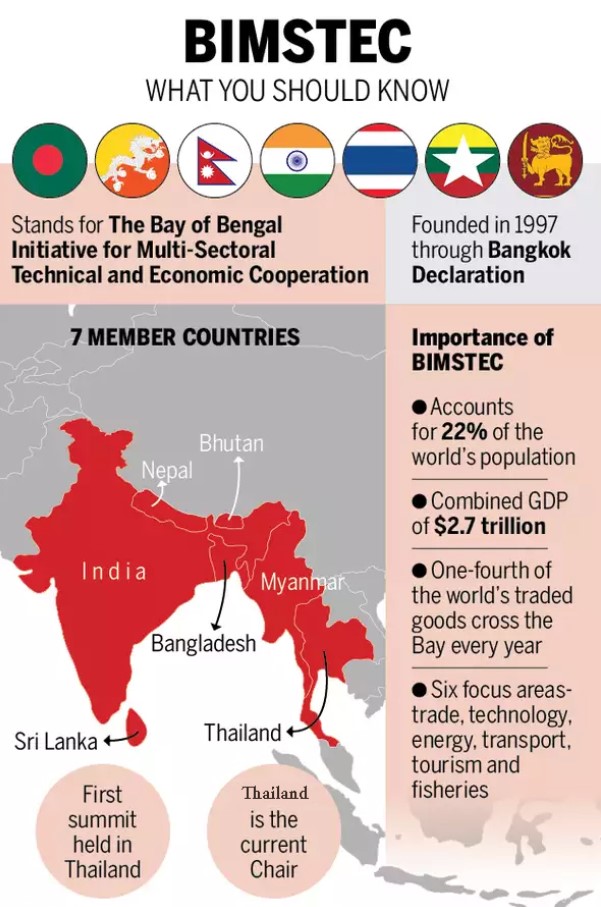CONTENTS
- A New Push in the Bay of Bengal
- Using Children’s Personal Data Legally and Securely
A New Push in the Bay of Bengal
Context:
India recently hosted the second BIMSTEC (Bay of Bengal Initiative for Multi-Sectoral Technical and Economic Cooperation) Foreign Ministers’ Retreat in New Delhi. This event aimed to provide an informal platform for discussions on enhancing cooperation and accelerating actions in areas such as security, connectivity, trade, and investment within the Bay of Bengal region.
Relevance:
GS2-
- India and its Neighborhood- Relations.
- Bilateral, Regional and Global Groupings and Agreements involving India and/or affecting India’s interests.
- Important International Institutions, agencies and fora – their Structure, Mandate.
Mains Question:
In the context of the recently concluded BIMSTEC’s 2nd Foreign Ministers’ Retreat, discuss the necessity of the BIMSTEC member states, especially India to push forth with a bold vision for the region. (15 Marks, 250 Words).
Significance of BIMSTEC for India:

- BIMSTEC, a regional organization focused on the Bay of Bengal, includes five South Asian and two Southeast Asian countries working together across seven different sectors.
- It offers New Delhi a chance to engage multilaterally with other nations in the Bay of Bengal region, which are crucial for India’s economic development, security, and foreign policy goals.
- Strengthening ties with its eastern neighbors is also vital for India, especially in light of China’s growing influence in the region, which could threaten regional stability and India’s role as a preferred security partner.
- Building strong relations with Bangladesh and Myanmar provides India with sea access for its landlocked northeastern region.
- Additionally, improved relations with Myanmar and Thailand would enhance India’s presence in the Indo-Pacific region.
- This is significant as these countries are part of ASEAN (Association of Southeast Asian Nations), which India considers essential to its Indo-Pacific strategy.
- Thailand emphasized this role at the retreat by positioning itself as a link between BIMSTEC and ASEAN.
- These priorities were highlighted in the opening speech by India’s Minister for External Affairs, S. Jaishankar, who noted that BIMSTEC aligns with India’s ‘Neighbourhood First’ policy, ‘Act East Policy‘ and the SAGAR (Security and Growth for All in the Region) vision.
More about the Retreat:
- The retreat was a preparatory step for the sixth summit meeting scheduled for September, where BIMSTEC leaders will meet in person for the first time since the pandemic.
- During the summit, they are expected to sign the BIMSTEC Agreement on Maritime Transport Cooperation to boost regional connectivity, a key objective of the group.
- The retreat was organized into two parts. In the first segment, participants evaluated the current state of regional cooperation within BIMSTEC, with India presenting on the implementation of key outcomes from the first retreat.
- Member states shared various ideas, such as establishing Centers of Excellence focused on Agriculture, Disaster Management, and Maritime Transport.
- India announced support for cancer research and treatment and the issuance of e-visas for patients from all BIMSTEC states, while Sri Lanka proposed adding kidney disease to this initiative.
- The retreat also emphasized the need to involve the private sector in trade, promote young entrepreneurs, and address connectivity, cybersecurity, and the trafficking of narcotics and illegal arms.
- In the second session, each country discussed its expectations for the upcoming summit. Sri Lanka stressed the importance of mapping the abundant mineral resources in BIMSTEC countries and creating opportunities for vertical integration in specific economic sectors to diversify production structures.
- Bangladesh emphasized cooperation in the Blue Economy and urged member states to ban fishing during the breeding season to tackle the issue of declining fish stocks in the Bay.
- Bhutan highlighted the need for collaboration in tourism and cultural exchanges, while Nepal presented its ‘whole of the region’ approach to leverage synergies among member states and transform BIMSTEC into a results-oriented regional forum.
- Thailand highlighted the need for cooperation in non-traditional security areas, and Myanmar added the necessity to combat online scams. These proposals will be presented to the heads of state before the September summit.
- While the retreat marked a multilateral milestone for India, it also offered bilateral benefits. Mr. Jaishankar had meetings with several of his counterparts on the sidelines.
- He expressed India’s concerns to Myanmar about the flow of displaced persons, narcotics, and arms across the border and urged for the return of unlawfully detained Indians.
- He also met with the Bangladesh Foreign Minister, who requested the smooth supply of daily essentials and asked for a technical team for the Teesta project, indicating progress on this longstanding issue.
Conclusion:
This year marks a decade since the introduction of India’s Act East and Neighbourhood First policies, with a focus on BIMSTEC reflecting New Delhi’s efforts to foster collaborative growth for national and regional well-being. Mr. Jaishankar encouraged future collaborations with new energy, resources, and a renewed commitment to cooperation. While it remains to be seen how many of these proposals will be realized at the forthcoming summit, the member states clearly demonstrated their intention to pursue a bold vision for the region at the retreat.
Using Children’s Personal Data Legally and Securely
Context:
The Indian school education system is one of the largest ecosystems in the world, comprising about 1.5 million schools, 9.7 million teachers, and nearly 265 million students from pre-primary to higher secondary levels. It includes stakeholders from diverse socioeconomic backgrounds. Undoubtedly, this extensive education system requires an effective management system.
Relevance:
GS2- Education
Mains Question:
Adherence to the principles of data privacy and data minimisation in the field of education is particularly pertinent given the sensitive nature of children’s personal data. Examine. (10 Marks, 150 Words).
UDISE+:
- To effectively manage this extensive education system, the Ministry of Education developed the UDISE+ platform in 2018. UDISE+ is vital for collecting and sharing real-time information on school infrastructure, teachers, student enrollment, and academic performance.
- This data enables the Ministry to create outcome-based policies to improve the quality of education in India.
- UDISE+ also plays a significant role in mapping educational trends, improving resource allocation, and monitoring educational programs, with the ultimate goal of strengthening administration and optimizing service delivery.
APAAR:
- Under the National Education Policy 2020, the Ministry introduced the Automated Permanent Academic Account Registry (APAAR), which provides a unique identifier for each student.
- This system helps compile students’ academic credentials in one place, including demographic information obtained with voluntary consent through Aadhaar.
- To enhance ease of schooling, steps are being taken to link APAAR and UDISE+, automate student admissions, reduce dropout rates during transitions, and increase opportunities for continued education.
- Entities like DigiLocker and ed-tech companies frequently collaborate with state governments, becoming integral parts of the modern education system.
- The integration of UDISE+ and APAAR, as described, exposes student data to these educational ecosystem actors.
Associated Challenges:
- The Education Ministry established a data-sharing policy for school education and literacy in 2020. However, this policy has yet to be updated to reflect changes following the Digital Personal Data Protection (DPDP) Act of 2023.
- Without clear regulations or minimum standards, especially for ed-tech players, their compliance with the Act is questionable.
- There are several potential pressure points where non-compliance by involved actors may occur. For example, there is limited guidance on what constitutes verifiable parental consent.
- Consent from parents for minors’ data, as required under the UDISE+/APAAR system, might not meet this requirement.
- Additionally, the DPDP Act stresses that personal data should only be collected for specific, legitimate purposes. Sharing children’s data under UDISE+ for purposes beyond those authorized could violate this legal requirement.
- The Ministry has recognized the benefits of sharing student data nationwide, such as tracking student migration between states.
- Therefore, efficiently managing educational records is crucial. Importantly, the DPDP Act mandates a specific and voluntary consent-based mechanism, emphasizing the need for explicit and voluntary consent for such purposes.
The Integration of Aadhaar in APAAR/UDISE+:
The Supreme Court recognized the right to privacy as a fundamental right in the case of Justice K.S. Puttaswamy (Retd.) v. Union of India (2018) and established a three-part test to evaluate state actions impacting citizens’ privacy rights.

- This test requires that: (i) there is a legitimate state interest in restricting the right; (ii) the restriction is necessary and proportionate to achieve this interest; and (iii) the restriction is imposed by law.
- The integration of Aadhaar in APAAR/UDISE+ must meet these three criteria. It is also crucial to exercise caution to prevent data theft and cyber breaches.
- Adhering to data privacy and data minimization principles is especially important given the sensitive nature of children’s personal data.
- The integration of third parties, such as DigiLocker, when exchanging children’s personal data for unspecified purposes, can raise concerns about their role.
- It is necessary to identify actors who qualify as data fiduciaries, data processors, and data principals to assign liability. This complex task is not currently being addressed.
- Although the privacy policy for APAAR outlines certain requirements for data security, aggregation, third-party integration, and retention, specific protocols are needed for sharing children’s personal data for unspecified purposes, and these are currently lacking.
- Moreover, both the data policy and the annual report highlight that the Ministry has no legal liability regarding the disclosure or accuracy of the data shared on UDISE+.
- The privacy policy directs grievances to a grievance officer, but there is no clarity on how legal liability is assigned or practically incurred.
- This reveals a significant lack of a grievance redressal forum and mechanism for data principals whose personal data is collected and shared under APAAR.
Conclusion:
Questions about interoperability, consent, and grievance redressal remain. Establishing standard operating procedures, both technical and legal, within an overarching governance framework is urgently needed. These protocols will help maintain data authenticity and outline legal obligations for stakeholders. Ideally, this will also encourage a conscientious approach among actors regarding the lawful and secure sharing, use, and retention of children’s personal data.





